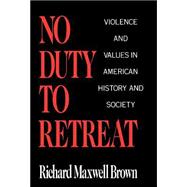
Note: Supplemental materials are not guaranteed with Rental or Used book purchases.
Purchase Benefits
What is included with this book?
| No Duty to Retreat in Law and the American Mind | p. 3 |
| The Gunfighter: the Reality Behind the Myth | p. 39 |
| California Conflict and the American Dream | p. 87 |
| The Persistence of No Duty to Retreat: Crime, Law, and Society in America from the 1850s to the Present | p. 129 |
| Conclusion: No Duty to Retreat in Retrospect and Prospect | p. 155 |
| Notes | p. 177 |
| Index | p. 253 |
| Table of Contents provided by Publisher. All Rights Reserved. |
The New copy of this book will include any supplemental materials advertised. Please check the title of the book to determine if it should include any access cards, study guides, lab manuals, CDs, etc.
The Used, Rental and eBook copies of this book are not guaranteed to include any supplemental materials. Typically, only the book itself is included. This is true even if the title states it includes any access cards, study guides, lab manuals, CDs, etc.